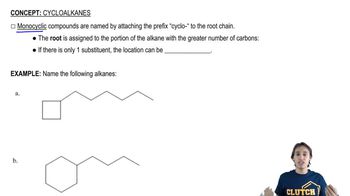Each of the following descriptions applies to more than one alkane. In each case, draw and name two structures that match the description.
c. a cis-diethylcyclohexane
d. a trans-dihalocyclopentane

 Verified step by step guidance
Verified step by step guidance Verified video answer for a similar problem:
Verified video answer for a similar problem:



 1:11m
1:11mMaster How to find the root name for cycloalkanes with a bite sized video explanation from Johnny
Start learning